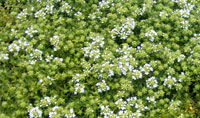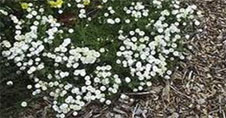Prostrate herbs for cracks and crevices, walls and paths
When you think of creeping herbs, the first plants which spring to mind are the thymes. Thymes like a dry sunny position and are ideal for growing in gravel areas, rockeries and on the tops of walls, between paving stones and for planting as thyme paths and lawns.

All of our creeping thymes prefer a light well drained soil in a sunny position,
or a container filled with a well drained compost.
They are excellent for paths, banks and rockeries, also at border edges and trailing over walls.
They are ideal for tubs and containers placed in a hot dry sunny spot.
All thymes are perennial and evergreen so you can create a permanent planting with interest and colour throughout the year.
They withstand walking on and are totally hardy.
Most popular at the moment is the creation of thyme paths, and indeed whole lawns on thyme!
Before planting it is important to ensure that the whole area is totally weed free,
as it is very difficult to extract dandelions etc from the tight mats of foliage that creeping thymes produce!
No need for extra fertiliser, as thymes thrive in poor soil, and flower all the better for it.
If you are planting in between paving stones then most prostrate thymes will divide up with a sharp knife,
to give a smaller root ball to insert in the cracks more easily.
Remember to water for several weeks until the roots have established themselves in the soil below.

White flowered thyme establishing as
part of a herb path

For a flowering display, the smaller herbs like chamomile and thyme have more impact
if planted together a group of 3 or more. Caraway thyme and Pink Ripple thyme planted together, for instance,
will have an extended flowering period as the caraway flowers first
and the Pink Ripple will follows on in about 2 or 3 weeks.
Think as well about the foliage during the periods when the thymes are not in flower.
White flowered thyme has lovely green foliage, whilst Doone Valley has bright gold and green variegations,
and creeping red thyme produces bronze hues in the autumn and winter.
 In addition to thymes, quite a few other herbs are low growing and suitable for the same planting positions.
Most well known is chamomile, both the lawn and double flowered varieties.
Also ideal is the bright foliage of All Gold lemon balm and the trailing stems of prostrate rosemary.
All of these will add new textures to your planting scheme.
In addition to thymes, quite a few other herbs are low growing and suitable for the same planting positions.
Most well known is chamomile, both the lawn and double flowered varieties.
Also ideal is the bright foliage of All Gold lemon balm and the trailing stems of prostrate rosemary.
All of these will add new textures to your planting scheme.
Remember that, when your herbs have finished flowering, it is time for a trim to keep them in shape
and promote lots of new growth for the rest of the summer.
If you trim them promptly then they will often reward you with another display of flowers in early autumn.
The various thymes respond well to this treatment and it stops them getting too long and straggly,
with lots of lovely new foliage swiftly growing up to cover the cut stalks.
Create a real centrepiece of colour and a haven for butterflies and bees when all these herbs are in flower.